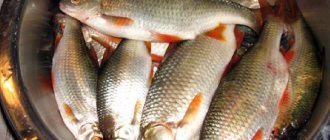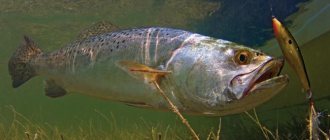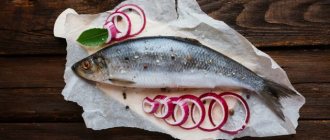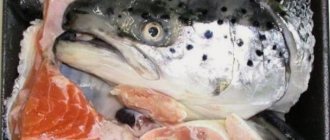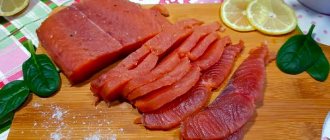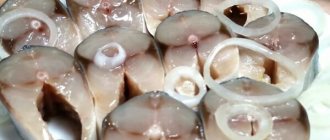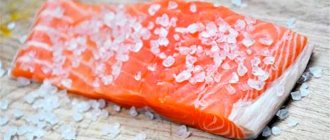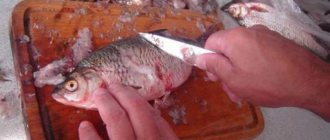All residents of Kuban and the Azov region know how to make ram: first, the fish is salted and then dried, as a result of which it acquires a special spicy taste and aroma. You won't find a better snack to go with beer!
The aromatic and tasty fish taranka (ram, ram) from the carp family has always been popular in the south of Russia and Ukraine - it was dried and served with beer. Subsequently, any dried fish, such as roach and roach, began to be called ram. Dried taranka was the most accessible and cheapest snack in Rus', so it was very popular.
All residents of Kuban and the Azov region know how to make ram: first, the fish is salted and then dried, as a result of which it acquires a special spicy taste and aroma. You won't find a better snack to go with beer!
The essence of the method is to quickly remove moisture from the product. Residual moisture in salted form should not exceed 20%. This effect is achieved by changing temperature conditions (hot and semi-hot). The process of drying rama in the oven is as follows:
Preparation of ram and specifics of its drying
First you need to understand what kind of fish you want to dry. This could be carp, roach, roach, bream, white bream, ruffe, gudgeon, small pike or sabrefish. As you can see, there is a very large selection!
Method of air drying roach strung on a thread
Important! For drying, it is better to use live fish. You can buy it or catch it yourself. It is not recommended to dry defrosted food at home!
Having decided on the choice of type, it must be cleaned of the entrails (milk, intestines, etc.) and rinsed well under running water. There is no need to remove scales, cut off heads and tails. Next, it is salted. There are two main methods of salting before drying:
Salting is a mandatory procedure before drying, otherwise the fish will spoil and rot. To prevent the formation of maggots, carcasses can be additionally treated with a 3% vinegar solution or dipped in unrefined sunflower oil. There are no restrictions regarding size and variety. The salting procedure follows a standard procedure. After all the manipulations carried out, the product is completely ready for drying; all that remains is to choose the optimal method.
Drying and drying fish is considered one of the ways to prepare and preserve it. After a certain time, pre-salted fish is dried in special devices. This can be a self-made device or an Isidri fish dryer. As a result, the product can be consumed without heat treatment.
Ecology of consumption: On the Don, ram is called dried roach, brought from the Volga. Previously, the rivers flowing into the Sea of Azov were literally overflowing with rams
Taran is one of the varieties of roach. It differs from ordinary roach in its greater body height, smaller scales, thicker teeth, and the number (fewer) of rays in the anal fin. Previously, ram came into trade in dried form and was a favorite food for the peoples of the Kuban, Don, and Azov regions. Today, the name ram refers not only to this type of fish, but also to mixed species of different breeds of fish.
On the Don, taranya is the name given to dried roach brought from the Volga. Previously, the rivers flowing into the Sea of Azov were literally overflowing with rams, and whole mountains of this dried product were brought to the fish market in the village of Gnilovskaya. Then the Chumaks transported the goods throughout Ukraine. But over time, the ram practically disappeared from the Azov basin due to its uncontrolled fishing even before spawning and the destruction of small individuals.
What fish is best for drying?
Almost any. But experienced fishermen prefer roach, rudd, minnows, and ruffs. Medium-fat fish such as roach, bream, sabrefish, and white bream are best suited.
Many people prefer to dry fish in natural conditions, in the fresh air, constructing numerous structures in the form of boxes with mesh. But if you want to dry a delicious delicacy as quickly as possible or the weather conditions do not allow it at the moment, then a completely ordinary oven, a Russian stove, or an electric dryer purchased in a store will do. In all cases, the preliminary preparation remains the same.
In the summer, it is better not to cook uneviscerated fish, since at this time herbivorous fish feed on plankton and greens, which during the drying process will give an unpleasant odor and rancid taste. If you want to dry a large fish without gutting, then before immersing it in brine, pour a strong salt solution into the abdomen through the mouth using a syringe or syringe.
Fully cooked fish has a structure that is clearly visible in the light, and no salt is released on its surface. After removing the scales and skin, a fragrant layer of meat, tender and elastic, and shiny fat appear. After drying, dried fish should mature from three weeks to a month.
How to dry fish?
Drying and drying fish is considered one of the ways to prepare and preserve it. After a certain time, pre-salted fish is dried in special devices. This can be a self-made device or an Isidri fish dryer. As a result, the product can be consumed without heat treatment.
Dried ram is made by salting, soaking and subsequent drying. The name comes from the roach fish (ram), which has long been used for this purpose.
Salting is carried out in one of the following ways: wet or dry. It is better to salt small fish using the wet method, while the dry method is used to salt large fish weighing more than a kilogram.
Wet salting method
Dry salting method
Salt is poured into a stainless steel bowl in a layer of about half a centimeter. The fish is thoroughly washed, the entrails of large specimens over 0.8 kg are carefully removed, and the small fish is salted whole. When dry salting, the fish is rubbed with salt from the tail to the head, the gills are tightly stuffed with salt and placed in a container in dense rows with the back to the stomach, head to tail, since with this method it is better to salt the fish under pressure. Salt must be poured inside the peritoneum of the fish.
If the ram is salted at home, then small fish are not gutted; in large fish, all the insides are removed along with blood clots. From the inside of the fish, a shallow incision is made to the dorsal fin without damaging the skin. It is better to use coarse salt, since fine salt forms a crust on the fish, and it does not allow the carcass to be salted evenly and efficiently.
Next, the fish is removed and washed thoroughly. Then they are soaked in water for two hours and rinsed again with the addition of table vinegar to prevent the appearance of living organisms in it. If an Isidri dryer is used, the gills of the fish are broken before drying so that they dry faster. If the specimens are large, then spacers are made from matches or toothpicks on the cut belly. This way it will remain fatty and more tasty.
How to store dried fish?
Well-dried fish should be stored in tin cans with tight lids.
How is ram useful and what is the best way to use it?
Fish contains many substances necessary for humans, but its calorie content per 100 grams is only 88 kcal. The protein content in it is 17.5 grams, fats – 2 grams, carbohydrates – 0.
Many people prefer to eat dried fish as a delicacy with beer. Dried roach is considered a classic. But not every fan can distinguish tasty fish by appearance. Tasty and good taranka has a pleasant dried taste, a beautiful color, without mold, it is not too soft, but not too dry, without yellowness. You should block the light source with the fish and then you can see how it lights up.
Ram is excellent as a snack for beer. These are integral components of each other. With moderate consumption of fish along with a foamy drink, this combination of goodies will only bring benefits, since beer contains a lot of B vitamins from brewer's yeast. This vitamin strengthens the heart muscle. Beer also contains a lot of ascorbic acid. And dried fish contains a lot of omega 3 fatty acids, which are useful for the prevention of cancer, senile dementia, stroke, and heart attack.
Of course, each fish has its own taste and it depends on the time it was caught and its habitat. For those who prefer oily fish, dried bream is best. If its drying took place with the belly not gutted, then when cut, the fat begins to literally ooze, the meat will taste aromatic and tasty.
Moderately fatty fish - dried sabrefish and vomer, which are distinguished by tender and tasty meat. Sea ruff has tender, tasty and nutritious golden meat. This fish cleans well and has very few bones. Dried perch has slightly sweet and fibrous meat that is lean. Dried pike has a rich and tart aroma and excellent taste.
Pregnant women can also consume dried fish in small quantities. Numerous tests have shown that pregnant women who consumed dried fish in the third trimester gave birth to calmer babies and a reduced risk of premature birth.
Dried fish can be used not only as snacks for beer. Sometimes it is used to prepare fish soup. Too dry specimens are ground into flour and used as a dressing for fish salads, fish soups, and cutlets.
There is another original recipe that uses dried fish. This is sour cream paste. To prepare it, mix a glass of sour cream with a quarter glass of mayonnaise, add a couple of tablespoons of lemon juice, a clove of garlic, a little black pepper, a tablespoon of parsley and a glass of chopped dried fish. This pasta can be served with dry salted cookies, cucumber or tomato slices.
Conclusion
Did you like the article? Write your opinion in the comments. Subscribe to our FB:
Proven benefits of dried fish:
Salting. Method number 2
If you approach the salting process more thoroughly, then you need to start with the container. Make a container for the future battering ram from a plastic or metal vessel. You need a stand for it so that the fish “drains”, or make a special bottom with holes in the tank so that the “juice” has somewhere to drain. Thin plywood with holes made around the circumference and in the center will serve as the bottom (however, it should not resemble a colander). You need to screw several blocks to the bottom of the plywood with screws, but so that there is a distance between them. Place the “tray” on the bottom of the tank with the blocks facing down. Sand the top part of the plywood with sandpaper.
Make a few more plywood “spacers”, but without the blocks. But holes will have to be drilled on each copy. Such products will overlap the next row of salting from the previous one, so it must be carefully adjusted to the walls of the tank so that there are almost no gaps. By the way, you need to start the rows with salt: pour it thickly and distribute it along the bottom of the container. The salt must be coarse and clean: all excess specks should be removed. The fish is placed on top, pre-washed and salted on both sides, and especially under the gills. You should not worry that there will be too much salt: the fish will take only “its own.”
Lay the layers tightly, sprinkle with plenty of salt so that it covers the fish and forms a flat surface. Press down with plywood spacer. The next row and all the others are fish-salt-overlap. Repeat until the very top of the tank, and put pressure on the top plate. It can be made from bags of river sand, stones, old cast iron irons, or a glass jar of water. Cover the top of the tank with a blanket. Pull it down to prevent flies and other insects, which are very attracted to the fishy smell, from getting under the blanket.
If you plan to dry fish on the balcony, then we recommend shading the place where the tank is located. After salting, the fish is soaked in running water: small fish for 30 minutes, larger fish are kept in water for several hours, and be sure to drain it twice. After soaking, the fish is kept in a container without water for 1.5-2 hours, and it acquires an amber-transparent color.
Now the time has come when the fish needs to be dried. It is allowed to dry completely, wiped with a rag and hung out (like laundry) to dry. It must be hung on special hooks that “hold” the fish by a hole pierced in its body with an awl. Moreover, small specimens should be hung upside down, and large ones should be hung upside down.
During the day, hung fish should be covered from insects with a thick layer of gauze or netting to prevent flies or wasps from laying larvae on it. However, the gauze should not touch the carcasses, and the fish should not come into contact with each other. At night, the protective cover in the form of gauze can be removed so that the ram “breathes” and forms a dry crust. Early in the morning, before closing it again with the canopy, sprinkle it with table vinegar dissolved in water.
The ram is dried for at least a week, but the drying period depends on various factors: the size of the carcass, the temperature. Store in tin cans with tight-fitting lids, in a cloth bag, in a covered basket, and always in a cool room. It “does not like” air: it oxidizes and acquires an unpleasant taste.
How to pickle taranka - salting methods
Taranka can be salted in several ways. Each one is good in its own way. The choice depends on how dry the snack should be after drying. With the wet method, it is possible to make the appetizer more spicy and prepare a fragrant salty brine. When dry salting, spices are added to the salt.
Wet
The wet salting method is suitable for carcasses of 0.5 kg. It is desirable that they are no larger in size. All you need is water, fish, salt. This type of salting is used more often.
Wet salting process:
Dry and wet salting in most cases occurs without adding spices. But they will never hurt the fish. The main thing is to choose the right spices.
What is suitable for ramming:
- allspice;
- Bay leaf;
- nutmeg;
- black pepper;
- coriander;
- carnation;
- ginger;
- cinnamon;
- red capsicum;
- mustard seeds;
- dill;
- caraway;
- anise;
- sugar.
Important! You need to add 50% sugar to the spicy brine.
Dry
When dry salting, it is advisable to cut the carcasses. Otherwise, the salt will have to be thoroughly rubbed into the gills and small cuts on the back and belly. It’s worth finding a suitable container in advance. For example, it could be an enamel basin.
How to pickle:
Important! The optimal option is soaking in fresh water, for as many hours as the number of days the fish lay under salt.
11. When the liquid stops dripping, move the ram to dry on a balcony or other well-ventilated place with a high temperature, where there are no flies. Place the carcasses at a distance of at least 5-7 cm from each other.
Theory
There are two ways to salt the ram: dry and wet. The wet method is simpler, but is only suitable for small fish weighing up to 400-500 grams and often worsens the aroma. Therefore, experienced fishermen salt taranka using a dry method.
Coarse rock salt without impurities or additives is required, as it draws out moisture well and does not saturate the meat with foreign odors. Iodized is not suitable!
You can salt fish for ramming in enamel dishes, as well as in glass or food-grade stainless steel containers, since these materials are not corroded by salt and do not affect the taste of homemade ramming.
Ingredients:
- fish – 1 kg;
- kitchen rock salt – 250-300 grams.
Cloudflare Ray ID: 63a80d952ff9c78d • Your IP: 195.64.208.251 • Performance & security by Cloudflare
The wet method, or as it is popularly called, the brine method, is used for both roach and other small fish. In this case, the roach itself is not washed, but only wiped dry with paper towels.
How to salt roach for wet drying
It is important that to salt roach you need to use coarse table salt, since it is the one that dissolves more slowly, absorbing almost all the moisture contained in the fish. To understand how to salt roach for drying, you need to learn the basics of salting any fish. To do this, you can use almost any deep container: an enamel bucket, a deep basin, a saucepan or a wooden barrel.
The bottom of the container must be covered with a generous layer of salt, and the fish itself must be laid in dense rows, carefully salting each of them. The last row must be salted so that the salt covers the entire fish.
To achieve an unusual and interesting taste, experts advise adding a little sugar.
After the roach has been carefully laid and salted, it must be covered with a flat lid and pressed down with a heavy weight to prevent the formation of gas bubbles and cavities in the roach, which contribute to the rotting of the fish. The brine that the fish releases after several hours is called brine, which is why the method itself received the name “brine.”
It is important that during salting, the fish is stored in a cold place, preferably in the refrigerator, since table salt penetrates into the fish itself slowly, and the cold helps prevent spoilage of the fish. Depending on the size of the roach, it must be salted for several days.
To check readiness, you need to take out one of the fish and try to bend it.
In prepared salted roach, the back becomes hard, the meat becomes dark gray, and the caviar becomes yellowish-red.
The finished salted fish must be removed from the container, rinsed thoroughly under cold running water, strung on twine, or bent paper clips threaded through the eye hole, then hung in a dry, ventilated room, covered with gauze so that insects do not land on the fish. It’s not difficult to guess how to dry roach correctly. It is worth noting that some fishermen advise leaving the fish not in the sun, but in a dry room with a draft, because that is when it will be juicy and meaty.
Cloudflare Ray ID: 63a80dbd7f370d46 • Your IP: 195.64.208.251 • Performance & security by Cloudflare
Cloudflare Ray ID: 63a80dbd8f5e0d46 • Your IP: 195.64.208.251 • Performance & security by Cloudflare
To implement all salting methods, you need to use only coarse salt, or iodized salt. Salted fish must be stored in a cool place, but not in the cold!
How to cook dried ram
Recipe: for 1 kg of fresh ram (average carcasses 200-250 grams) at least 0.5 packs of salt. Larger specimens are kept in a saturated solution - brine. The solution is saturated with salt so that raw potatoes float in it. Carcasses up to 250 g are not gutted before drying. Large fish are freed from giblets.
The generally accepted method of drying all carp fish:
- wiping carcasses,
- Sprinkling tightly packed layers of fish with salt or pouring brine,
- exposure under pressure for several days, depending on the size of the fish.
- soaking, getting rid of excess salt,
- hanging to dry.
All methods of soaking and drying are detailed. They are well suited for drying ram.
When wet salting, the fish is dipped in bunches into the brine. When it starts to peek out, more salt is added to it. Small rams are kept for a couple of days, large fish - five to six. The fish in the brine is often stirred so that the brine evenly covers all the carcasses.
There is a lot of debate about how to hang fish when drying: by the head or tail. You should not catch it by the gills or lips, it is better to pierce it through the eyes. Hanging by the tail is more difficult, but in this case the saline solution flows out through the mouth faster, excess salt accumulates under the gills, and flies cannot lay eggs there.
When drying, careless owners see salt appear on the scales, the fish tastes unpleasant, quickly rusts, and some fish are spoiled by insects. The fat rendered from the heat quickly goes rancid, and the fish acquires an unpleasant bitterness.
Winter preparation of dried ram according to Astrakhan recipes
Avid fishermen keep wooden barrels in their basements, into which brine is poured for salting fish. Spring and autumn catches are placed in them. And they are stored in this form until the dry winter cold. In winter, the ram is taken out of the brine, soaked, hung on the balcony or outside the windows, kept in light frost for a couple of weeks.
In the cold, the fish does not spoil, the fat remains in the carcasses, and there are no insects. Drying is more convenient in winter; fish is stored well for a whole year in a cool place. Before use, the bunch is warmed in the house. The surplus can be sold. Hermetically sealed dried ram is stored for 10 months.
Concept of the drying process
Drying any product involves getting rid of excess moisture in one way or another. The same applies to drying fish: moisture is removed from the carcasses, the meat becomes denser, acquiring a piquant aroma. At the same time, fish oil and other nutrients are preserved in the pulp, so this delicacy can be called a storehouse of useful microelements.
Theoretically, it is possible to dry salt-free fish in an oven or a special dryer, but does this make sense? Such a semi-finished product requires subsequent soaking and cooking, that is, in this case, the goal is only to preserve a large catch for the purpose of its subsequent use in cooking. A freezer is much better suited for these purposes.
People often ask how the drying process differs from drying? Practically nothing, just drying is a production process, and drying is a handicraft process. In production conditions, it is possible to bring the product to optimal condition while maintaining beneficial properties. If you try, you can achieve a similar result at home. So, let's begin?
Selection and preparation of carcasses
This process works best in the spring (before spawning) and autumn. Firstly, at this time the fish accumulates sufficient reserves of fat, so the meat acquires the best taste. In summer, especially in the first half, representatives of the freshwater ichthyofauna are still recovering from the breeding season, and their meat is a bit tough and not as tasty as we would like.
However, this does not mean that fish dried in summer is not suitable for food at all: it is quite possible to eat it, even with great pleasure. The problem is different: during the warm period, the number of insects goes off scale, wanting to feast on a potential delicacy or use it to reproduce their own kind. Therefore, the issue of protecting drying carcasses from persistent attacks of wasps and flies comes to the fore.
There are no insects in winter, which is good news, but the temperature conditions are far from optimal, and the humidity sometimes goes off scale. During this period, it is recommended to move the process to the balcony (if you have a glazed one) or use artificial heat sources.
In general, the process can be carried out year-round, simply by modifying its conditions. In this case, you can take absolutely any fish. Roach and its subspecies (ram and roach), silver bream, bleak, bream and so on are optimal. Perch, pike perch and pike are somewhat dry, but there are also lovers of the tough meat of the predator. Flat-bodied fish dry best, so it makes sense to cook tench or carp in a different way.
It is necessary to select fresh, undamaged carcasses that have retained the integrity of their scales. The slightest odor or other signs of decomposition will negatively affect the quality of the final product.
Before salting, carcasses must be thoroughly rinsed in running water, paying special attention to the gill slits. To gut the fish or not is a matter of taste and season. There are a few things to consider:
Salting fish
To salt fish before drying, the “wet” method is usually used. Unlike the dry method, it does not involve the outflow of brine (brine) from the container with fish. This way, the carcasses are salted better, throughout the entire volume, and the process proceeds faster. However, we can use any option of your choice:
To implement all salting methods, you need to use only coarse salt, or iodized salt. Salted fish must be stored in a cool place, but not in the cold!
Soaking and preparation for drying
Before drying, salted fish should be tested for doneness. If, when pressed with a finger, a dent forms in the carcass, and the spine makes a characteristic crunch when stretched, the fish has reached the desired condition. Otherwise, you still need to wait a day or two.
If, after salting, the carcasses are not washed and soaked, the fish will be “eaten” by the salt: the meat will turn out to be tough and salty to the point of impossibility. Therefore, it is recommended to rinse each carcass under running water, thoroughly washing the gills and gutted bellies. Then you need to pour water into a large saucepan or bucket and lower the fish into it. Soaking is carried out according to the following principle: the fish should be in the water for as many hours as the number of days it was salted, plus one. The water needs to be changed every hour.
Designs for drying
If you have to dry a small portion of small items, you can do without hanging the carcasses. You need to lay foil on the table or windowsill, and clean paper on it. You need to lay out small change on these layers and cover it on top with light natural fabric or gauze (the last point is relevant in the summer, as it provides protection from flies). The fish will have to be turned over daily, replacing the sodden paper with dry paper as necessary. However, you need to be prepared that the room will smell of fish, and this aroma is not for everyone.
Where can you dry fish naturally?
Optimal conditions for drying are low humidity, good ventilation, and protection from direct sunlight. Protection from blowflies, which strive to lay eggs in delicious carcasses, and wasps, which literally gnaw decent pieces out of fish, is also important.
And if you can still put up with wasp passages, then the offspring of the fly swarming inside the carcass automatically makes it unsuitable for ingestion. Therefore, all methods of drying fish outdoors in the warm season must provide appropriate protection in the form of light fabric or a mosquito net.
So, fish can be dried by hanging:
Depending on the conditions, the fish is completely dried in 3-5 days, but sometimes it takes a week or more.
Using household appliances
Using household appliances can make the drying process easier. If you follow some technological nuances, you can successfully dry small carcasses even without salt. Our grandmothers also dried small items in Russian ovens, not bothering at all with cleaning and sometimes salting. Now an alternative to the oven has become a mediocre oven.
The oven drying process looks something like this:
It is also good to use electric dryers for these purposes, and preference should be given to models specially designed for drying fish and meat. Closed electric dryers are optimal: they do not smell as fragrant during the process.
Storage of the finished product
Everyone dries the semi-finished product to their taste: some like slightly dried meat, others like it almost wooden-like. In this regard, drying times vary significantly, but rarely does anyone hang carcasses for longer than 5-7 days.
The scales of the finished fish are slightly shiny with fat, but no salt crystals appear on them. The skin is thick, but comes off relatively easily. The meat is elastic and dense, translucent, with a characteristic spicy taste, without bitterness or signs of mold.
In fact, dried fish of this condition, already removed from the wire, is ready to become an original delicacy, but connoisseurs recommend bringing it to perfection in a cool place, wrapping it in culinary parchment or placing it in a linen bag.
Salting fish (video)
Related articles:
| Spinning rod rigs (Texas, Carolina, dropshot) | Fishing knots and leashes, knot strength | |
| Fishing with surface baits (gliders) | Propbait fishing (lure with a propeller) | |
| How to choose a popper, what to look for when choosing | Devon fishing (unique spinner with a propeller) | Do-it-yourself spinnerbait (making and fishing) |
| DIY fishing crafts | |
| Review of the best balancers for ice fishing | |
| Fishing with jigs: varieties, gear, fishing techniques | |
| Types of fish finder echo sounders for fishing | |
| Review of aluminum fishing boats | |
| How to choose a spinning reel? | |
| Electric motors for inflatable boats (review) | |
| Aluminum fishing boats | |
| Which coil to choose for a feeder - overview of characteristics | |
| Characteristics and capabilities of feeder rods |
Now is the time to talk about taranka, because from now on and throughout the winter, this is the best time to prepare it. Well, let's start with the fact that we, Kremenchu residents, call dried roach ram, and when I visit friends, I had to try ram from bream, perch, pike perch, pike, catfish and even crucian carp. And my friends are right too, because according to Wikipedia:
Taranka, taranka is a common name for dried dried fish. Basically, various fish of the carp family, the genus Rutilus, roach, such as ram (from the name of which the concept of “ram” arose) and roach are used to prepare ram. It is considered a Russian national snack for beer.
So what is important to know when preparing this delicious and popular fish product?
The first and most important thing in this matter is the body density of the fish. The density of the fish depends on the water temperature and time of year. The highest body density of fish is in October – November. This time coincides with the maximum feeding of fish. Then you get the most delicious battering ram. But not everyone manages to catch a large number of roaches at this time. Of course, traditionally there is also winter and, of course, spring. All this time it is actively feeding and with certain skills you can catch it and catch quite a few. Naturally, with successful fishing, it is not possible to process all of it, so you just need to sprinkle it well with salt in a large plastic bag (like those that ship soot at a soot plant) or in a plastic food container and store it in a cold place (cellar or old refrigerator in garage (if, of course, there is an extra one for this purpose). But in any case, you need to hang out all the caught ram before the onset of warm weather. Summer roach, no matter how hard you try, will not make a particularly tasty roach. The reason for this is the low density of the fish, its stomachs filled with organic matter and not the first freshness when transported in the heat. Well, the ram made from roach, red bream, saberfish and blue bream is considered a classic. Moreover, the last two types of fish in our rivers have become very rare, but if you know where to catch them, you should know that in order to prepare ram from them, the specimens must not be small. White bream is considered an amateur ram, but bream is quite difficult to prepare (it is better to smoke it) and this is a separate topic on HOW to properly make ram from it. I have one good friend, and he knows how to cook dried bream so that you can choke on your saliva while it dries. Therefore, I want to tell you how to prepare ram from roach, because this is what I catch for this purpose most often and most of all.
So, if you managed to catch a roach - that’s great, no - you can buy it, it’s less time-consuming, but more expensive in terms of money + You won’t get the same pleasure from fighting with this strong and beautiful fish! The most delicious is, of course, spring fish with caviar. Males are less tasty, but this is not a reason to ignore them. It is advisable to immediately after fishing divide the fish by size, dividing them into large, medium and small. And salt all types separately. The smaller the container, the easier it is to salt the fish. I consider ideal plastic food containers, which can now be bought WITHOUT PROBLEMS in any market and in any volume, so to speak. Under no circumstances should the fish be gutted, because then all the fat will come out of it and it will lose half of its taste + (which is definitely) it will lose its appetizing appearance! The fish is placed in rows and salted in layers. No need to skimp on salt! The salt should completely cover the fish. For larger specimens (today it’s 350 grams or more) - take an individual approach, i.e. Don’t be too lazy to pour salt under the gills of each fish.
I dry fish on the balcony, although it’s clear that this is far from the best place and my wife is not particularly happy with it. I try to finish with all the strategic stocks of ram (including those stored in the freezer) before the appearance of flies capable of reproducing. Because it is extremely difficult to protect yourself from them, they even find some kind of cracks in special drying nets, or I don’t know how they throw their worms there so that they end up on the fish. :(And then your fish will have to be used only purely for breeding maggots. As for the drying time, I think this is all purely individual. Personally, I don’t like overdried fish, even if it’s better if it has a little blood on it (then it’s 2-3 days of drying for small fish and 4-5 for large ones) because salt begins to appear on overdried fish and the fat dries out and it is no longer so tasty. BUT... as they say, “There are no comrades for taste and color.” Therefore, good luck to you all and bon appetit! !!
kerescan — Sep 23rd, 2015
In addition to ram, bream, crucian carp, asp, pike, carp, pike perch and some other types of fish can be salted in this way. For small fish, 2-3 days are enough for salting, for medium fish – 5-10 days, for large fish – 7-12 days.
